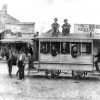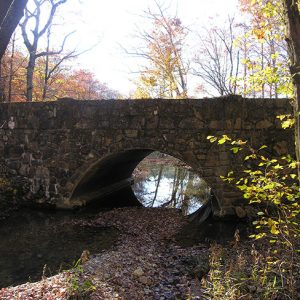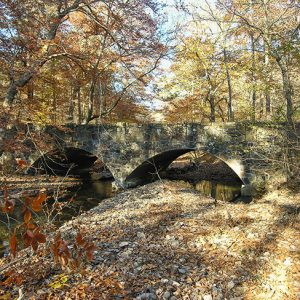calsfoundation@cals.org
Shady Lake CCC Bridges
The Shady Lake CCC Bridges were nominated to the National Register of Historic Places under Criterion A with local significance for their association with the work of the Civilian Conservation Corps (CCC) in Polk County. The bridges, completed by crews from Camp Shady in December 1936, were constructed as a part of the Shady Lake Dam project begun in October 1935. The CCC originally developed the area for recreational purposes, and the bridges and road still service numerous camping and picnicking sites around the lake in the twenty-first century. The Shady Lake CCC Bridges were also nominated under Criterion C with local significance as a good example of CCC native-stone bridge construction. These single-span structures are supported by arched, corrugated steel culverts and cross the South Fork of the Saline River. The bridges were added to the National Register in 2010.
The CCC played an especially significant role in Arkansas during the 1930s. The 742nd Company, located sixteen miles southeast of Mena (Polk County), was the second CCC camp in Arkansas. (The first CCC camp in Arkansas, 741st Company, was established at Camp Pike and moved to Crystal Springs Camp on May 17, 1933.) Nestled in the mountains of the Ouachita National Forest, the 742nd Company camp was named “Shady” after a town that once existed two miles to the west. On June 15, 1933, 200 CCC recruits set up tents and began construction on their new camp. They completed the work on July 11, 1933, and began field work the following day. Camp Shady’s project district covered about 133,920 square acres, within which CCC men fought fires and built or improved roads, bridges, dams, and other infrastructure.
One of the CCC’s major contributions to Polk County—and the rest of the country—was the development of recreational infrastructure, such as the Shady Lake Recreation Area in the Ouachita National Forest. When the CCC was first formed, recreational development was approved by the U.S. National Park Service and was largely limited to state and national parks. On February 7, 1935, CCC director Robert Fechner approved a memorandum authorizing his crews to complete recreational work in state and national forests. Two days later, the Camp Shady newsletter, Flashes from Shady Gap, announced the construction of a dam that would form a twenty-five-acre lake at the junction of the Saline River and Blaylock Creek. By October, a crew of twenty-five men had surveyed the dam site and cleared about five acres around the proposed lake.
With only finishing touches left to complete on the dam, crews began construction on a road that would encircle the newly formed lake and service its recreational facilities. Workers had to construct two bridges along the road, one spanning the East Fork of the Saline River and one spanning the South Fork. The CCC hired James F. Harp of Hot Springs (Garland County) to provide technical assistance during construction of the bridge headwalls, which began in the summer of 1936. Harp, along with a Mr. Outler, were put in charge of the crew building the Shady Lake CCC Bridges. They completed the bridges in December 1936. The bridges were added to the National Register of Historic Places on October 10, 2010.
For additional information:
“Shady Lake CCC Bridge #1.” National Register of Historic Places nomination form. On file at Arkansas Historic Preservation Program, Little Rock, Arkansas. Online at https://www.arkansasheritage.com/docs/default-source/national-registry/pl0284-pdf.pdf?sfvrsn=aebad8c0_0 (accessed November 15, 2025).
“Shady Lake CCC Bridge #2.” National Register of Historic Places nomination form. On file at Arkansas Historic Preservation Program, Little Rock, Arkansas. Online at https://www.arkansasheritage.com/docs/default-source/national-registry/pl0285-pdf.pdf?sfvrsn=88fb2329_0 (accessed November 15, 2025).
Benjamin Harvey
Arkansas Historic Preservation Program



 CCC Staff
CCC Staff  Shady Lake CCC Bridge No. 1
Shady Lake CCC Bridge No. 1  Shady Lake CCC Bridge No. 2
Shady Lake CCC Bridge No. 2 



My grandfather was part of this group of CCC workers who worked on construction of the Shady Lake area. So proud to still be able to enjoy it today. He also worked on the fire tower on the mountain above Shady Lake Tall Peak.